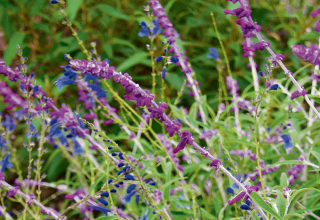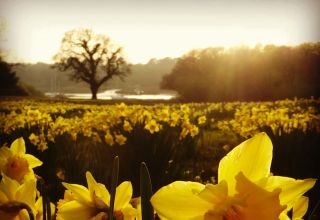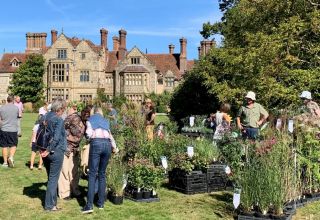
by Andrew Midgley
Cerney House Gardens lies in the secluded Churn Valley in the Cotswolds outside the Roman town of Cirencester, in Gloucestershire on the outskirts of North Cerney.
It’s a garden that oozes romance and style whatever the season.
The Bathurst Arms, on the A435, is the indicator that you are near these wonderful gardens approached opposite the pub up a winding lane towards the church.
You arrive at Cerney House through a drive with sweeping lawns on either sides with the Georgian house nestling in a dip surrounded by majestic beech trees providing a much needed windbreak. The car park is situated to the left of the house and visitors are entrusted to pay their admission via an honesty box. There is a small, self-service tea room in the Bothy within the Walled Garden where again you pay via another honesty box.
The house and gardens were bought by the late Sir Michael and Lady Angus in 1983 and it was Lady Angus and her daughter Barbara MacKenzie who set about rejuvenating the walled garden and the wider parts of the garden.
On leaving the car park, the path leads to the walled garden and another path takes you through the woodlands which is adorned with various cultivars of snowdrops in February which the gardens are deservedly famous for, giving you tantalising glimpses of the formal garden below you.
Here you’ll find 150 different varieties of snowdrops. The woodland track leads around the rear of the property and eventually you find yourself in front of the house where you can walk across the lawn to the ha-ha via a path to an area known as the Avenue Beds, created in the mid -1990s, which has two long and deep borders with a tall prunus trimmed into a hedge to act as an backdrop. Close by is a young arboretum that’s beginning to establish itself with a good collection of Japanese flowering cherries plus a stately Liriodendron tulipifera, tulip tree.
Beyond is a water garden which was extended approximately 15 years ago and has a stream trickling through. Looking back up to the house, your eyes are surprisingly drawn to the right hand side of the building and not the centre as you would expect, as to the left of the borders is a wildflower meadow that stops near the drive. When the snowdrops finish, clumps of wood anemones and aconites take their place followed by bluebells within the woods before it’s the time for the daffodils to have their turn.
As you wander through it becomes clear this is a garden full of unexpected surprises and a credit to the late Lady Angus and Barbara. The garden is now run by her son, Nick Angus and his wife, Janet with the help of four part time gardeners, who want to further the garden’s development and potential.
The walled Victorian garden is gardened organically and loosely in the style of the English Romantic Garden with old-fashioned roses and drifts of perennials. It is approximately three and a half acres and the borders are long and rectangular in shape. The entrance to the walled garden is via a wrought iron gateway with two stone acorns on the walls. To the right is a Victorian greenhouse and the old gardener’s bothy.
Below the glasshouse are a group of both red and yellow flowered tree peonies. Essentially the walled garden is divided into two halves divided by a central gravel path. The walled garden on the right is on a south-facing slope catching the maximum sunlight for the fruit and vegetable garden.
Intriguingly, the walls on this side are made of traditional red Victorian bricks whilst the lower side of the walled garden consists of dark stones which makes for a direct contrast in texture and colour. The bricks help to capture the warmth of the sun which radiates heat at night that aided fruit production back in the olden days. Along the top path there are old espaliered apple trees where in the corner is a venerable old medlar tree (Mespilus germanica) underplanted with hybrid hellebores in the spring. Behind the trained fruit trees is an old asparagus bed.
The walled garden are hosts to Roman snails which can cause a few headaches for the gardeners in the vegetable garden but are legally protected under the Wildlife and Countryside Act of 1981.
On the left is the ornamental half with drifts of perennials consisting of hardy geraniums, astrania, hemerocallis, spires of lupins and delphiniums and so forth and bordered by a straggly line of old, bedraggled, yet gnarled characterful lavenders and hyssops which helps softens the edges of the path. On entering the walled garden, the eye is lead up to the imposing gazebo built in the 1990s as an anniversary present for Sir Michael and Lady Angus. From the gazebo, you can see the walled garden in its entirety and there are plans to change the planting around the gazebo in 2017 in memory of the late Lady Angus using white and green flowers and renaming that spot as the Legacy Garden.
The skeletal frameworks of the roses will burst into leaf and be at their best in June. The renowned roses, ‘Paul’s Himalayan Musk’, ‘Rambling Rector’, ‘William Lobb’ and ‘American Pillar‘ are just four of the roses jostling for attention in the bustling but harmonious borders whilst the early, yellow flowering Rosa lutea grows on the wall.
So many formal gardens can be too manicured and in some sense become soulless but you get the impression that the garden here is allowed to run riot with timely intervention by the gardeners to temper the plants and thereby making it a serene, quiet and relaxing garden to wonder around enjoying the intoxicating scents from the roses and from the scented garden near the Knot Garden.
One of the features here is the intricately woven clipped box hedges in the Knot Garden with four quince trees planted in each border with a stone sundial in the middle. In the spring, the beds are planted with bold drifts of tulips which are superbly set off by the bright green leaves of the hedges; an absolute classic planting combination for a formal garden. Each year, different colour combinations are used to freshen the display and the spent tulips are then replanted in the herbaceous borders. The Knot garden is surrounded by grass paths and by old fashioned scented roses supported on rustic wooden trellises via a spectacular Laburnum arch.
Every garden needs to change and Cerney Gardens are no exception. Plans are afoot to rejuvenate the vegetable garden using old fashioned heritage vegetables.
This year the new custodians of Cerney House will allow well behaved dogs on leads into the garden and there are plans to create more interests for children too.
You could, like me, quite happily spend a few peaceful hours soaking up this wonderful old atmospheric garden.
Cerney House Gardens
The Garden House, North Cerney, Cirencester. Glos, GL7 7BX.
Email: gardens@cerneygardens.com
Tel: 01285 831300.
Opening times are seven days a week, 10am till 5pm, end of January to the end of October.
Call to arrange visits outside these times.












